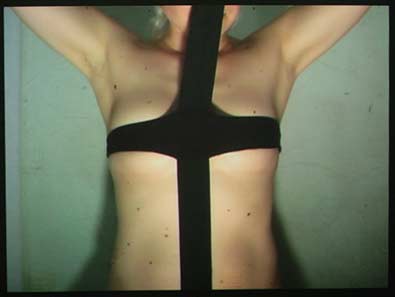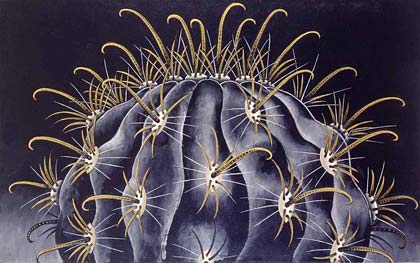science

A new way of using the genetic code has been created, allowing proteins to be made with properties that have never been seen in the natural world. The breakthrough could eventually lead to the creation of new or “improved” life forms incorporating these new materials into their tissue.
In all existing life forms, the four “letters” of the genetic code, called nucleotides, are read in triplets, so that every three nucleotides encode a single amino acid.
Not any more. Jason Chin at the University of Cambridge and his colleagues have now redesigned the cell’s machinery so that it reads the genetic code in quadruplets.
In the genetic code that life has used up to now, there are 64 possible triplet combinations of the four nucleotide letters; these genetic “words” are called codons. Each codon either codes for an amino acid or tells the cell to stop making a protein chain. Now Chin’s team have created 256 blank four-letter codons that can be assigned to amino acids that don’t even exist yet.
{ NewScientist | Continue reading }
photo { Maria Petschnig, Born to Perform, 2009 }
future, genes, science | February 18th, 2010 5:08 pm

The Galton board, also known as a quincunx or bean machine, is a device for statistical experiments named after English scientist Sir Francis Galton. It consists of an upright board with evenly spaced nails (or pegs) driven into its upper half, where the nails are arranged in staggered order, and a lower half divided into a number of evenly-spaced rectangular slots. The front of the device is covered with a glass cover to allow viewing of both nails and slots. In the middle of the upper edge, there is a funnel into which balls can be poured, where the diameter of the balls must be much smaller than the distance between the nails. The funnel is located precisely above the central nail of the second row so that each ball, if perfectly centered, would fall vertically and directly onto the uppermost point of this nail’s surface.
Each time a ball hits one of the nails, it can bounce right (or left) with some probability P (and q = 1 - P). For symmetrically placed nails, balls will bounce left or right with equal probability, so P = q = 1/2. If the rows are numbered from 0 to N - 1, the path of each falling ball is a Bernoulli trial consisting of N steps. Each ball crosses the bottom row hitting the nth peg from the left (where 0≤ n ≤ N - 1) If and only if it has taken exactly n right turns, which occurs with probability

{ Wolfram MathWorld | Continue reading }
from the archives { The whole system—the nine thousand polystyrene balls dropping through a pegboard of 330 precisely cantilevered nylon pins, the real-time photoelectric counters tallying (by LED readout) the segmented heaps forming below, the perennially balky bucket-conveyor for resetting an experimental run—had all been painstakingly constructed and calibrated in order first to exemplify, and then to defy, what the Victorian statistician Francis Galton dubbed the “Law of Frequency of Error.” | Cabinet | Continue reading }
archives, mathematics | February 18th, 2010 5:02 pm

Doctors eventually determined that Mrs. Lee had suffered from broken-heart syndrome. (…) The mysterious malady mimics heart attacks, but appears to have little connection with coronary artery disease. (…)
For reasons that aren’t fully understood, the problem, formally known as stress-induced cardiomyopathy, afflicts mostly women after menopause. The syndrome is relatively uncommon, accounting for an estimated 1% to 2% of people—and about 6% of women—who are diagnosed with a heart attack. In addition to such common emotions as grief and anger, doctors say broken-heart syndrome has been triggered by a person’s anxiety over making a speech, a migraine headache or the emotional response to a surprise party. It can be fatal on occasion, but for the most part patients recover quickly, with no lasting damage to their hearts.
In a conventional heart attack, an obstructed artery starves the heart muscle of oxygenated blood, quickly resulting in the death of tissue and potentially permanently compromising heart function. In contrast, the heart muscle in broken-heart-syndrome patients is stunned in the adrenaline surge and appears to go into hibernation. Little tissue is lost.
{ Wall Street Journal | Continue reading }
health, science | February 18th, 2010 5:00 pm

If I call you, will you call back? The study of reciprocity between mobile phone users reveals surprising insights about the flow of information in society.
What do your mobile phone habits say about you? Probably more than you might imagine.
At least, that’s the suggestion from Lauri Kovanen and pals at the Aalto University School of Science and Technology, Finland. These guys have studied the 350 million calls made by 5.3 million customers over an unnamed mobile phone network during a period of 18 weeks. The primary question they ask is whether mobile phone calls are mutually reciprocated: in other words, does somebody who calls another individual receive in return as many calls as he or she makes, a phenomenon known as reciprocity.
Mobile phone calls are a particularly good way to study reciprocity because they are directed in a way that sms messages and email are not. In a mobile phone call, the caller initiates the conversation and then both parties invest a certain amount of time in the event. But afterwards there is usually no immediate reason for the recipient to call back. So it’s clear who initiated the event.
But SMS messages or e-mails are entirely different: here a conversation usually means sending a sequence of reciprocated messages and this makes it much more difficult to study reciprocity by simply counting the number of messages.
{ The Physics arXiv Blog | Continue reading }
economics, relationships, science, technology | February 11th, 2010 8:32 am

The long-term effects of short-term emotions
The heat of the moment is a powerful, dangerous thing. We all know this. If we’re happy, we may be overly generous. Maybe we leave a big tip, or buy a boat. If we’re irritated, we may snap. Maybe we rifle off that nasty e-mail to the boss, or punch someone. And for that fleeting second, we feel great. But the regret—and the consequences of that decision—may last years, a whole career, or even a lifetime.
At least the regret will serve us well, right? Lesson learned—maybe.
Maybe not. My friend Eduardo Andrade and I wondered if emotions could influence how people make decisions even after the heat or anxiety or exhilaration wears off. We suspected they could. As research going back to Festinger’s cognitive dissonance theory suggests, the problem with emotional decisions is that our actions loom larger than the conditions under which the decisions were made. When we confront a situation, our mind looks for a precedent among past actions without regard to whether a decision was made in emotional or unemotional circumstances. Which means we end up repeating our mistakes, even after we’ve cooled off.
{ Harvard Business Review | Continue reading }
ideas, psychology | February 4th, 2010 9:24 am

Who are the best spreaders of information in a social network? The answer may surprise you.
The study of social networks has thrown up more than a few surprises over the years. It’s easy to imagine that because the links that form between various individuals in a society are not governed by any overarching rules, they must have a random structure. So the discovery in the 1980s that social networks are very different came as something of a surprise. In a social network, most nodes are not linked to each other but can easily be reached by a small number of steps. This is the so-called small worlds network.
Today, there’s another surprise in store for network connoisseurs courtesy of Maksim Kitsak at Boston University and various buddies. One of the important observations from these networks is that certain individuals are much better connected than others. These so-called hubs ought to play a correspondingly greater role in the way information and viruses spread through society.
In fact, no small effort has gone into identifying these individuals and exploiting them to either spread information more effectively or prevent them from spreading disease.
The importance of hubs may have been overstated, say Kitsak and pals. “In contrast to common belief, the most influential spreaders in a social network do not correspond to the best connected people or to the most central people,” they say.
{ The Physics arXiv Blog | Continue reading }
illustration { Martin Wong’s Ferocactus }
ideas, science, technology | February 4th, 2010 9:24 am

Imagine that your stockbroker - or the friend who’s always giving you stock tips - called and told you he had come up with a new investment strategy. Price-to-earnings ratios, debt levels, management, competition, what the company makes, and how well it makes it, all those considerations go out the window. The new strategy is this: Invest in companies with names that are very easy to pronounce.
This would probably not strike you as a great idea. But, if recent research is to be believed, it might just be brilliant.
One of the hottest topics in psychology today is something called “cognitive fluency.” Cognitive fluency is simply a measure of how easy it is to think about something, and it turns out that people prefer things that are easy to think about to those that are hard. On the face of it, it’s a rather intuitive idea. But psychologists are only beginning to uncover the surprising extent to which fluency guides our thinking, and in situations where we have no idea it is at work.
{ Boston Globe | Continue reading | Thanks James! }
photo { Helmut Newton, Nova magazine, Paris, 1973 }
economics, psychology | February 4th, 2010 9:22 am

“How we process information is related not just to our brains but to our entire body,” said Nils B. Jostmann of the University of Amsterdam. “We use every system available to us to come to a conclusion and make sense of what’s going on.”
Research in embodied cognition has revealed that the body takes language to heart and can be awfully literal-minded.
{ Natalie Angier/NY Times | Continue reading }
brain, psychology, science | February 4th, 2010 9:21 am

Why are people so blissfully ignorant of certain aspects of their personalities?
Take an everyday example: there are some infuriating people who are always late for appointments. A few of these people explain it by saying they are ‘laid-back’, while others seem unaware that they’re always late.
For laid-back people, their lateness is a part of their personality, they are aware of it and presumably not worried about appearing unconscientious. For the unaware it’s almost as if they don’t realise they’re always late. How is that possible?
It’s probably because they’ve never noticed or paid attention to the fact that they are always late so they never learn to think of themselves as lacking conscientiousness. Or so suggests a psychological theory describing how we think about ourselves called self-schema theory.
This theory says that we have developed ’schemas’, like internal maps of our personalities, which we use to understand and explain our current and future behaviour to ourselves, e.g. I’m always on time for meetings so I’m a conscientious person.
However schema theory also suggests that these maps have uncharted areas, leaving people with certain blind spots in their self-knowledge.
{ PsyBlog | Continue reading }
psychology, relationships | February 4th, 2010 9:20 am

The patient was a 15-year-old girl employed in a local bar. She was admitted to hospital after a knife fight involving her, a former lover and a new boyfriend. Who stabbed whom was not quite clear but all three participants in the small war were admitted with knife injuries. (…)
Precisely 278 days later the patient was admitted again to hospital with acute, intermittent abdominal pain. Abdominal examination revealed a term pregnancy with a cephalic fetal presentation. The uterus was contracting regularly and the fetal heart was heard. Inspection of the vulva showed no vagina, only a shallow skin dimple was present below the external urethral meatus and between the labia minora. An emergency lower segment caesarean section was performed under spinal anaesthesia and a live male infant weighing 2800 g was born…
The patient was well aware of the fact that she had no vagina and she had started oral experiments after disappointing attempts at conventional intercourse. Just before she was stabbed in the abdomen she had practised fellatio with her new boyfriend and was caught in the act by her former lover. The fight with knives ensued. She had never had a period and there was no trace of lochia after the caesarean section. She had been worried about the increase in her abdominal size but could not believe she was pregnant
{ Discover | Continue reading | ABC }
artwork { The Designers Republic }
mystery and paranormal, science, sex-oriented | February 4th, 2010 9:18 am

Chronic pain is associated with a loss of the normal capacity to know where your body is. Chronic pain is also associated with odd bodily feelings. To find out if people with chronic back pain had trouble ‘feeling’ their back, they were asked to draw on a piece of paper the outline of where they felt their back to be. This is a bit tricky to understand, but imagine you are surveying, in your head, how your body feels and then drawing its location. Anyway, you might have to read the paper to really get it. This is what we found: six out of six patients with low back pain, when they were trying to draw where they felt their back to be, said “I can’t find it” or “I’ve lost it”. When an independent investigator assessed sensory acuity on the back, sensory acuity was reduced in the same place the patient couldn’t feel properly. (…)
In short we think it demonstrates that chronic back pain is associated with distorted body image of the back.
{ Body in Mind | Continue reading }
health, psychology | February 4th, 2010 9:18 am

When most people think about geography, they think about maps. Lots of maps. Maps with state capitals and national territories, maps showing mountains and rivers, forests and lakes, or maps showing population distributions and migration patterns. And indeed, that isn’t a wholly inaccurate idea of what the field is all about. It is true that modern geography and mapmaking were once inseparable. (…)
In our own time, another cartographic renaissance is taking place. In popular culture, free software applications like Google Earth and MapQuest have become almost indispensable parts of our everyday lives: we use online mapping applications to get directions to unfamiliar addresses and to virtually “explore” the globe with the aid of publicly available satellite imagery. Consumer-available GPS have made latitude and longitude coordinates a part of the cultural vernacular. (…)
Geography, then, is not just a method of inquiry, but necessarily entails the production of a space of inquiry. Geographers might study the production of space, but through that study, they’re also producing space. Put simply, geographers don’t just study geography, they create geographies. (…)
Experimental geography means practices that take on the production of space in a self-reflexive way, practices that recognize that cultural production and the production of space cannot be separated from each another, and that cultural and intellectual production is a spatial practice.
{ The Brooklyn Rail | Continue reading }
illustration { Olivier Vernon }
ideas, science | February 4th, 2010 9:15 am

You can’t buy happiness, but you can at least inherit it, said British and Australian researchers, after studying a thousand pairs of identical and non-identical twins. Their Eureka! on happiness is: Genes control half the personality traits that make people happy, while factors such as relationships, health and careers are responsible for the rest of our well-being.
The researchers identified common genes in identical twins that result in certain personality traits and predispose people to happiness. Sociable, active, stable, hardworking and conscientious people tend to be happier, the researchers reported in Psychological Science.
{ The Hindu | Continue reading }
More than a century ago, an Irish economist named Francis Edgeworth imagined a futuristic device that he called a hedonimeter. It would be, Edgeworth speculated, “an ideally perfect instrument, a psychophysical machine.” His hedonimeter would measure happiness by “continually registering the height of pleasure experienced by an individual.”
This may sound more like something out of science fiction than an idea from the annals of economic history. But Edgeworth’s fantasy grew out of his utilitarian approach to economics, with its assumption that the best way to make choices and allocate resources was to aim to maximize happiness in society. Today, the idea that happiness can indeed be measured and quantified remains at the heart of a new science of happiness.
Over the last few decades, psychologists, neuroscientists, sociologists, behavioral economists and other social scientists have been busy using cold, hard data to try to fill in some of the blank spaces on the map of human happiness. It turns out that no hedonimeter is necessary. Much of the latest data on happiness is generated simply by asking people how they feel. (…)
As historian of happiness Darrin McMahon said in a paper he presented at a 2006 Notre Dame conference on the subject, people “have never been as preoccupied, never been as obsessed, I would argue, with happiness as they are right now.”
{ University of Notre Dame | Continue reading }
read more { Happiness: Cognition, Experience, Language | Collegium, Volume 3, 2008 }
genes, ideas, psychology, science | January 28th, 2010 5:26 pm

In the late 1970s, while working as a chiropractor and naturopath in Fergus, Ont., James Wilson began noticing patients with circadian rhythms out of whack.
They had trouble waking up in the morning, needed caffeine to get through the day, and felt a drop in energy mid-afternoon. Their second wind came at 11 p.m., revving them up for three hours.
Their deepest sleep, work permitting, was between 7 and 9 in the morning. They felt tired and unable to concentrate.
Their condition improved, Wilson says, when he treated their adrenal glands, boosting the hormones involved in regulating the body’s daily rhythms and dealing with stress.
His diagnosis was based on the pioneering work of the late Montreal endocrinologist Dr. Hans Selye. Modern life, Wilson concluded, is so relentlessly stressful that adrenal glands get overworked, burn out and produce lower levels of hormones needed to cope with stress.
Wilson says he coined the term “adrenal fatigue,” calling it the “21st century stress syndrome.”
{ Toronto Star | Continue reading }
health, science | January 28th, 2010 5:25 pm

Why do some clubbers shake it like a Polaroid picture while others prefer to perch on a bar stool? British psychologist Peter Lovatt, who has conducted rigorous field work in nightclubs, believes he can explain why some booty shaking is hot — and some is not. It’s all about your hormones. (…)
“Men can communicate their testosterone levels through the way they dance,” said Lovatt. “And women understand it — without noticing it.” (…) In women, the link between dancing style and testosterone levels were similar — but the reaction of men was just the opposite.
{ Spiegel | Continue reading }
photo { Arseni Khamzin }
music, relationships, science | January 28th, 2010 5:25 pm

Six months is all it took to flip Europe’s climate from warm and sunny into the last ice age, researchers have found.
They have discovered that the northern hemisphere was plunged into a big freeze 12,800 years ago by a sudden slowdown of the Gulf Stream that allowed ice to spread hundreds of miles southwards from the Arctic.
Previous research had suggested the change might have taken place over a longer period — perhaps about 10 years.
The new description, reminiscent of the Hollywood blockbuster The Day After Tomorrow, emerged from one of the most painstaking studies of past climate changes yet attempted.
{ Times | Continue reading }
climate, horror, science | January 28th, 2010 5:25 pm

Pharmaceutical companies are always on the lookout for secondary drug targets. After all, if you invest billions developing a single drug, you would be more than happy to sell it as a treatment for two, three, or more different ailments. Sildenafil citrate was developed to treat angina and hypertension. During phase I clinical trials, it was found that Sildenafil induces penile erections. The drug was branded Viagra, and the rest is history. Eflornithine, an anti-cancer drug, is also effective against the agent of African Sleeping Sickness, Trypanosoma brucei. African Sleeping Sickness belongs to a group of diseases known as “neglected diseases”, for which drug development is not profitable. However, having a drug already on hand makes it easier to market in affected areas.
Another example of polypharmacology is a drug that binds to multiple targets in the human body. This could be used for overcoming drug resistance, a known problem with cancer. Cancer tumours often develop a resistance to anti-cancer drugs because the protein that the drug bind to mutates, and no longer binds the drug. However, if the drug acts by binding redundantly to several proteins, it would be more effective, since several mutations would be required to effect drug resistance.
{ Byte Size Biology | Continue reading }
drugs, health, science | January 28th, 2010 5:24 pm

…walk around. First walk normally, with your arms swinging. Then try it with your arms folded. Finally, do it with your arms and legs on each side in phase, swinging forwards and back at the same time – a “tick-tocking” motion. (…)
If you have carried out this little experiment, then you will probably have noticed that the second and third ways of walking are more difficult. But why? The answer – as it is for many important questions in biomechanics – is more complicated than you might think. (…)
One might assume that we already know all about how the organs and whole bodies of organisms – particularly Homo sapiens – work. Movements and forces at the macroscopic scale are, after all, relatively straightforward to measure and subject only to the laws of classical physics. Moreover, the anatomy of our bodies has been mapped for hundreds of years compared with the 10 years for which we have had comprehensive guides to the human genome. Surprisingly, however, research by biomechanics – people who combine expertise in both biology and physics – continues to uncover and fill hitherto undreamed-of areas of our ignorance about ourselves.
{ Physics World | Continue reading }
science | January 28th, 2010 5:24 pm

Several great psychology and neuroscience studies were published in 2009. Below I’ve chosen 10 that I think are among the most noteworthy. (…)
1. If you have to choose between buying something or spending the money on a memorable experience, go with the experience. (…)
8. Turns out, saying you’re sorry really is important—and not just to you. (…)
9. We can become bored with just about anything, but there may be a way to reverse the habituation blues.
{ True/Slant | Continue reading }
psychology | January 28th, 2010 5:23 pm

Is there life after death? Theologians can debate all they want, but radiation oncologist Dr. Jeffrey Long says if you look at the scientific evidence, the answer is unequivocally yes. Drawing on a decade’s worth of research on near-death experiences — work that includes cataloguing the stories of some 1,600 people who have gone through them — he makes the case for that controversial conclusion in a new book, Evidence of the Afterlife. (…)
Medically speaking, what is a near-death experience?
A near-death experience has two components. The person has to be near death, which means physically compromised so severely that permanent death would occur if they did not improve: they’re unconscious, or often clinically dead, with an absence of heartbeat and breathing. The second component [is that] at the time they’re having a close brush with death, they have an experience. [It is] generally lucid [and] highly organized.
{ Time | Continue reading }
illustration { Jong Myung Hwang }
experience, mystery and paranormal, science | January 28th, 2010 5:22 pm























